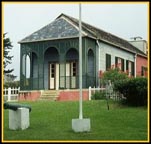


|
The Age of George III |
I am happy that you are using this web site and hope that you found it useful. Unfortunately, the cost of making this material freely available is increasing, so if you have found the site useful and would like to contribute towards its continuation, I would greatly appreciate it. Click the button to go to Paypal and make a donation.
 Longwood
House on St Helena
Longwood
House on St Helena
By the time Napoleon died on the Island of St Helena in 1821 at the age of 52 he was a very sick man but the nature of the illness that killed him has never been established for certain. Some doctors have argued that he died of cancer, others that he was poisoned by one of his retainers. Still others have argued that his death was hastened accidentally by toxic vapours in his house on St Helena from wall paper dyed with arsenic.
Napoleon spent the last six years of his in exile at Longwood House on the South Atlantic island of St Helena. The house's drawing room was decorated with wallpaper with green and brown rosettes. An English chemist tested a scrap of the paper in 1982 and found that the green shades (the lighter parts of the rosettes) had been dyed with a commonly used pigment - arsenic
The wallpaper in question |
|
The inscription reads ' This small piece of paper was taken off the wall of the room in which the spirit of Napoleon returned to God who gave it'. |
A close-up of the fragment of wallpaper
|
In 1982 a US specialist Dr Robert Greenblatt, came up with a new diagnosis suggesting that, far from being a sick man, the former emperor of France was becoming a sick woman. Dr Greenblatt, who specialises in the study of hormones, says that Napoleon was suffering from a glandular disease called the Zollinger-Ellison syndrome. The disease, he says, explains why one of the doctors who examined the emperor's body after his death observed: 'His type of plumpness was not masculine; he had beautiful arms, rounded breasts, white soft skin (and) no hair.'
The disease, which was not understood at the time, left another clue, according to Dr Greenblatt. Napoleon was an ardent lover during his marriage to his first wife, Josephine but he admitted that he had little interest in lovemaking after he married his second wife. Marie Louise, in 1810.
Napoleon tried to poison himself once, in April 1814 after surrendering to the Allies. However, the phial he used was two years old and had lost its potency. It merely gave him a violent attack of hiccups, which made him vomit and saved his life. Without the hiccups, the 1815 Battle of Waterloo would probably never have taken place.
| Meet the web creator | These materials may be freely used for
non-commercial purposes in accordance with applicable statutory allowances
and distribution to students. |
Last modified
12 January, 2016
|